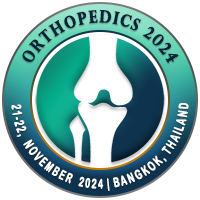
Sean Garcia
East Kent Hospitals University Foundation Trust, United KingdomTitle: Clinical and Radiological Outcomes of BOX Total Ankle Replacements in a District General Hospital
Abstract
Background- The Bologna- Oxford (BOX) total ankle replacement (TAR) became a popular procedure to treat end-stage osteoarthritis and was designed to provide unconstrained, congruent movement of the bearing surfaces whilst retaining the surrounding ankle ligaments.
Objectives- This study aims to present clinical and radiological outcomes, in addition to survivorship in a series of 46 TARs performed in an independent district general hospital in the United Kingdom.
Methods- We retrospectively analysed data on 46 TARs performed in a single centre between 2011-2019. Radiological outcomes such as periprosthetic loosening and coronal alignment were recorded. Clinical outcomes inclusive of the Manchester-Oxford foot Questionnaire (MOXFQ) were recorded, as was survivorship.
Results- Data was collected from 46 patients with a mean age of 73.03 +/- 7.78 years and a mean follow-up of 52 months (range: 2- 67.2 months). There was a significant improvement in mean MOXFQ scores (20.96 +/- 13.53, p< 0.01) when compared to preoperative scores. Aseptic radiological loosening was seen in three cases (6%), two (4%) occurring on the tibia and one (2%) having both tibial and talar radiolucency. Infection was noted in 4 (8%) cases, half of which were deep infections. Three cases (6%) developed tibialis posterior tendinopathy. Mean lateral distal tibial angles (LDTA) were 91.2 +/- 3.99. None of the patients were revised, however, fourteen patients were lost to follow-up.
Conclusion- We report excellent clinical and radiological outcomes in the BOX TAR. Although we report a 100% survivorship, this should be interpreted with caution given the patients lost to follow-up.
Biography
Background- The Bologna- Oxford (BOX) total ankle replacement (TAR) became a popular procedure to treat end-stage osteoarthritis and was designed to provide unconstrained, congruent movement of the bearing surfaces whilst retaining the surrounding ankle ligaments.
Objectives- This study aims to present clinical and radiological outcomes, in addition to survivorship in a series of 46 TARs performed in an independent district general hospital in the United Kingdom.
Methods- We retrospectively analysed data on 46 TARs performed in a single centre between 2011-2019. Radiological outcomes such as periprosthetic loosening and coronal alignment were recorded. Clinical outcomes inclusive of the Manchester-Oxford foot Questionnaire (MOXFQ) were recorded, as was survivorship.
Results- Data was collected from 46 patients with a mean age of 73.03 +/- 7.78 years and a mean follow-up of 52 months (range: 2- 67.2 months). There was a significant improvement in mean MOXFQ scores (20.96 +/- 13.53, p< 0.01) when compared to preoperative scores. Aseptic radiological loosening was seen in three cases (6%), two (4%) occurring on the tibia and one (2%) having both tibial and talar radiolucency. Infection was noted in 4 (8%) cases, half of which were deep infections. Three cases (6%) developed tibialis posterior tendinopathy. Mean lateral distal tibial angles (LDTA) were 91.2 +/- 3.99. None of the patients were revised, however, fourteen patients were lost to follow-up.
Conclusion- We report excellent clinical and radiological outcomes in the BOX TAR. Although we report a 100% survivorship, this should be interpreted with caution given the patients lost to follow-up.

